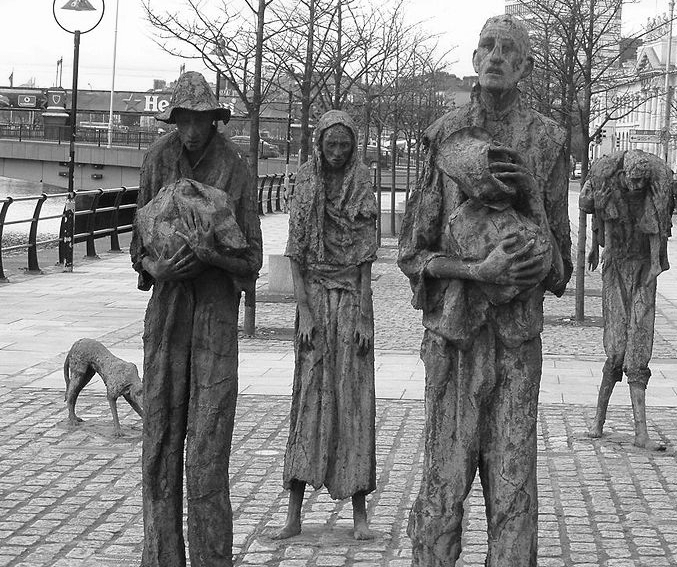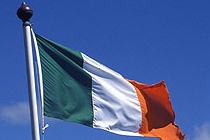The Great Hunger: Ireland 1845-1849 by Cecil Woodham-Smith

The horror of what is casually referred to as the "Potato Famine" is meticulously chronicled in the superb and immensely readable "The Great Hunger: Ireland 1845-1849", by Cecil Woodham-Smith. The first paragraph sets the tone:
At the beginning of 1845, the state of Ireland was as it had been for nearly seven hundred years, a source of grave anxiety to England. Ireland had first been invaded in 1169; it was now 1845 yet she had been neither assimilated nor subdued. The country had been invaded not once but several times, the land had been conquered and redistributed over and over again, the population had been brought to the verge of extinction – after Cromwell's conquest and settlement only some half million Irish survived - yet an Irish nation still existed, separate, numerous and hostile.
The population had increased during the period following the rape of Ireland by Cromwell in 1649, to 8 million in 1845. It was during Cromwell’s war on Ireland that an estimated 40% of the land was confiscated and transferred to the ownership of the English Nobility. Two hundred years later the population of Ireland was poor, landless and 3 million Irish are said to have subsisted on a diet of potatoes alone. The blessing, and the curse, of the potato is that it is nearly the perfect food and with a wee bit of milk, it is possible to live a healthy life on the potato alone. The Potato Blight made its appearance in 1845 and by 1846 had destroyed the Potato Crop. As 1847 arrived, three million souls were in immediate danger of death by starvation. The blow dealt by blight was followed by the monstrous actions of the land owning aristocrats, the majority of whom lived their lives of luxury in England funded by rents extracted annually from the Irish Celt. The land owners were estimated to have caused the eviction of a half million Gaels from their homes during the famine years. The combination of famine and homelessness led to the unspeakable deaths of one million Celtic souls, many dying in road side ditches.
This book is widely accepted as one of the most comprehensive and authoritative accounts of the Famine due to Woodham-Smith’s expert use of official archives. She was from an aristocratic and wealthy background and benefitted from an upper class British education. However, hidden beneath this petite sophisticated persona was the burning heart of an Irish Patriot. Woodham-Smith, born Cecil Blanche Fitzgerald, was the descendant of Lord Edward Fitzgerald, who died in a Dublin prison from the wounds suffered when he resisted arrest on charges of Treason for his leading role in the failed Irish Rebellion of 1798.
The events of 1847 stand out in Woodham-Smith’s telling. For it was 166 years ago this Spring that the Coffin Ships began to ply their deadly trade across the Atlantic transforming into a flood of horror, disease and unspeakable human suffering. Desperate to get out of Ireland and misled by agents who promised assistance upon arrival in Canada, an estimated 100,000 made the passage that year. In many cases the landlords paid for the ocean passage and in one last act of savagery too often did not provide sufficient food and water for the crossing. Typhoid and dysentery plagued the vessels and scenes from hell were common. The Toronto Globe reported in August 1847 on one of the worst of the arriving ships:
A medical officer at the quarantine station at Gross Isle off Quebec reported that ‘the few who were able to come on deck were ghastly yellow looking spectres'.
Yet throughout the agonizing recanting of what is the “Celtic Holocaust”, the author resists assignation of blame for the horrifying deaths of over one million Irish people, blame which many historians have easily pinned on the inaction of the British Government. This was a government whose primary objective according to the author “was not to improve Ireland but to bring her more completely into subjection”, the very same objective that drove Cromwell to pillage Ireland two hundred years earlier. What better way to achieve this evil objective than to allow a million Irish to starve and force a second million souls to flee, too many consigned to the hell of the “Coffin Ships”.
The bitter legacy of the famine was not confined to Ireland. The author makes a profound observation on the unintended consequences of the perceived actions, or inaction, of the British Government:
The famine emigration, the exodus from Ireland, in which hundreds of thousands of Irish, with fever on the one hand and starvation on the other, fled from their country because to remain was death, is historically the most important event of the famine. It was the famine immigrants – leaving their country with hatred in their hearts for the British and the British Government – who built up communities, above all in the United States, where the name of Britain was accursed, and whose descendants continued to be Britain’s powerful and bitter enemies, exacting vengeance for the sufferings their forebears endured.
The bitterness and hatred of the Irish in America towards Britain was still a formidable factor in the desperate competition between the Allies and Germany for American support during the First World War. A competition eventually won by Britain due in part to the devious support of Britain by Woodrow Wilson and the East Coast elites. But it was by no means a certainty that the United States would enter the war on the side of Britain. The attitudes of the Irish in America towards the conduct of the United Kingdom during the Famine nearly cost Britain America’s decisive support which led to an allied victory.
In his 2013 work, “America’s Greatest Blunder – The Fateful Decision to Enter World War I”, Burton Yale Pines describes the impact of the legacy of the Famine on the struggle to win America’s support for the Allies. Second only to German-Americans as a percentage of the population of the United States who numbered 8.2 million, Irish Americans numbered 4.5 million strong based on the 1910 census. The bulk of the Gaels being descended from the refugees who fled the horror of The Hunger. They blamed the English. The Author writes:
By 1914 the Irish were playing leading roles in America’s labor movement as well as wielding enormous influence in the U.S. Roman Catholic Church and were beginning to take control of big city politics. What counted for Germany was that all America’s Irish were deeply hostile to Britain. The Gaelic-American, the Irish World and other Irish newspapers, several which began receiving adds from German firms, incessantly attacked Britain and strongly and repeatedly urged Irish-Americans to take actions to prevent America from leaning towards London. Organizations such as the United Irish-Americans Societies, among other things, mobilized their members to demonstrate at cinemas, forcing them to cancel British propaganda movies, while the American Truth Society, an Irish-led group (with many German-American members), acted to counter British propaganda directly.
The ending paragraphs of this riveting account of death and misery point to the consequences of the famine on Ireland’s relationship with Britain. Consequence which extended into the mid twentieth century:
Time brought retribution. By the outbreak of the Second World War, Ireland was independent, and she would not fight on England’s side. There was also a more direct payment. Along the west coast of Ireland, in Mayo especially, on remote Clare Island, and in the dunes above Six Mile Strand are a number of graves of petty officers and able seaman of the British Navy and Merchant Service, representatives of many hundreds who were drowned off the coast of Ireland, because the Irish harbours were not open to British ships. From these innocents, in all probability ignorant of the past, who never heard of failures of the potato, evictions, fever and starvation, were exacted part of the price for the famine.
So the mind wanders who or what was to blame for the carnage? Was it the spore of the Potato Blight that turned the staple of the Irish diet into a stinking putrid mass or was it the British Governments facilitation of continued agricultural exports from Ireland as the Gael starved in mud huts within sight of the river traffic? Was it a deliberate policy of Ethnic Cleansing carried out by London under the mask of bureaucratic obfuscation? Was it the viciousness of the majority of landowners who capitalized on the potato blight to rid themselves of unruly tenants? Perhaps the culprit is simply the malevolent indifference of the British ruling class. Upon an honest read of this monumental work on the "Celtic Holocaust", one is forced to decide.
Get your copy from Amazon.com (US$) or Amazon.co.uk (GB£):
- Irish
- English






